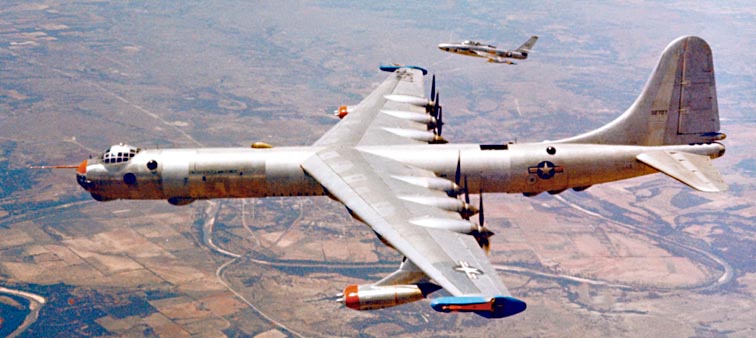One of the strangest planes to modern eyes is the B-36, an absolutely huge bomber originally designed to carry out Canada to Berlin bombing raids (in case Britain fell to the Nazis) and Hawaii to Japan bombing raids. By the time it was ready, its mission had changed: to carry the really big hydrogen bombs of the 1950s. Wikipedia describes it as the largest piston engine plane ever built. More than size, it used pusher propellers:
As you might expect, with six engines, the flight engineer's console was pretty impressive. Go here for a scrollable and zoomable image of it.
UPDATE: Castle Air Force Museum in California's Central Valley has one of these that I saw many years ago. One of my readers took these pictures of one at the Pima Air Museum in Tucson last month. (For some reason, I can't link to them directly.)

That had 4 jet engines to go with the 6 props, didn't it?
ReplyDeleteSix piston engines, AND four jet engines, at least on the later models. They are on those pylons out by the wingtips.
ReplyDeleteThere is a B-36 on display at the Pima Air Museum in Tucson and I shot some pictures of it about a month ago. In person the airplane is astonishing, more imposing even than the B-52 bombers also on display there.
ReplyDeletewww.flickr.com/photos/corgifan/8719256844/
http://www.flickr.com/photos/corgifan/8719256884
When it shows up on late-night television, the movie Strategic Air Command starring (Brigadier General) Jimmie Stewart is a great show of B36 and B47 tech.....
ReplyDeleteThere's also a B-36 in the Air Force Museum in Dayton, OH. Near it is an original landing gear assembly, that used a single wheel and tire. Turned out that the concentrated pressure was too much for the concrete runways, so they had to redesign it to use multiple wheels.
ReplyDeleteThe Dayton bomber was equipped with a trapeze-like mechanism to launch/recover a miniature jet fighter for self-protection.
The sad thing about the B-36 at the Dayton Museum is that it is inside. While you can really get a good look at every part of it, you can't stand back from it and see how huge it really is. I noticed the same thing about the Spruce Goose when I saw it in Long Beach many years ago.
ReplyDeleteThe Dayton Museum is still a great place though. Highly recommended.
You can look down on the B-36 and compare the size to the B-52 from the upper floor of the missile observation gallery at Dayton. You have to walk out to a section that most people don't seem to wander towards since there's nothing there except a bare hallway to the observation gallery, but it's worth it to get the elevated view of the post-WW2 display area.
ReplyDeleteAs you say, highly recommended and a great picture. You really get a feel for the relative sizes of all the planes and a fantastic view. I just wish I had a phone with a panorama feature on it when I went there.
I love standing under the bomb bays of the Dayton bomber...getting the good look of the guts of the plane. I've always wanted to be able to explore everything...and use the transport tubes they used to get from the front to the back of the plane. Of course...now I'd probably get stuck!
ReplyDelete